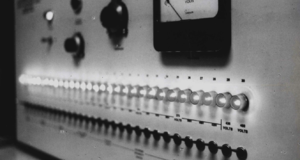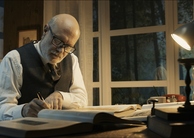On Understanding Abstract Portraits: Applying Cognitive Semiotics and Psychophysiological Symbolism
By
2014, Vol. 6 No. 11 | pg. 3/3 | « Instead, the portrait communicates through extrinsic symbolism, we might link the long, willowy form of the torso with grace and patience, the curvature of the leaf-hair and torso forms with the physiology of maternal caregivers. These inferences of association are based upon sociocultural context and framing as much as they are personal experience. Referring again to “Puzzles,” note also that Gilot's head, originally planed as a long oval shape, was instead spontaneously turned on its axis as a wide blue paper oval impressed upon the canvas. This aids in the Picasso's expressive representation of Gilot's personality by introducing the semiotic properties of that shape and color. These interpretations are subjective, but the tools which the artist intentionally (if not necessarily deliberately) gives to us in order to come to these interpretations are the focus of this essay. Psychophysiological Symbolism allows us to analogously give expressive content to formal elements of artworks as displays, in addition to direct human behavioral displays. This is achieved through a chain of cognitively and socially ascribed associations; first between physiological display-aspects and felt-emotion, and then between the relevant instance of Psychophysiological Symbolism and certain formal content elements observed in the artwork.So, in terms of the medium and creative communication, in encountering an abstract portrait we draw parallels between the certain formal content elements and Psychophysiological Symbolism so as to see such points of content as emotionally expressive – and thus representative of various personality traits and characteristics of the portrait's subject. Psychophysiological Symbolism, as a principle, makes light of how we abstractly express emotion and the ways in which we read into, and bring our socioemotional Selves into perceiving such abstract expressive displays within an artistic encounter. Going beyond its instrumental use as a frame for systems of symbolic communication, it also functions as a set of learned sociocultural idea-structures that condition and inform our seemingly-innate concepts and means of emotional expression insofar as Psychophysiological Symbolism stands as an integrated part of the sociocultural context which shapes our socioemotional Selves. Through this, the Self contributes to how we perceive content as expressive, made emotionally relevant to us and our subjective experiences – communicated qua how extrinsic symbolism, as a part of our sociocultural developmental context, serves as a more lucid communicative framework thanks to the artist's work with the medium. Thus, this essay argues that the interpretation of certain artworks, specifically abstract portraits, is a profoundly social-psychological phenomenon, a dialogue - as asserted by Carroll's quote at the beginning of this essay - an emotional discourse. Rather than regarding the phrase “emotional discourse” as mere analogy this essay asserts that it indeed refers to a particular discursive structure through which communication and meaning-making occurs, by way of artistic expression, recognition, and interpretation. According to Foucault: “any act of representation involves three positions that human beings may occupy...the representer...the represented...and the representee...in seeing the representation the representee is also a subject.” (1970) Knowing this, we can understand artist and audience as mutually made subject to one another under the emotional discourse. The networks of extrinsically symbolized associative aspects are directly influenced by one's sociocultural developmental context and comprise the language of this proposed discursive structure. It follows that the ways in which associative aspects are cognitively accessed and reorganized into novel relations of signifiers and the signified to form meaningful idea-structures about the artwork's content are largely dependent on our ability to approach the portrait as a social stimulus. It has been expressed that viewers, in their interpretation of a piece, bring meaning into an artwork that an artist did not originally intend for the work (Nathan 2005). Artworks, understood as catalysts of creative social interaction, rather than linear one-way displays, are grounded in the intentions of the artists, according to Dilworth, and may act as a guide for a viewer’s interpretation of a work as an appraisal is constructed in response to the interaction. Therefore, a viewer’s ascription of meaning to the display that the artist did not intend is actually an extension of the viewer’s response-appraisal, a veiled expression of his Self in response to the work, informed by but conceptually separate from the artwork itself – hence the emotional discourse. This is the perpetuation of instances of dialogue, as proposed by Carroll at the beginning of this essay. The presence of self and other; a framed concept of the artist, peers to whom our reactionary dialogue takes place, and most importantly, the depicted subject of the portrait, as recognized by the viewer; all of these are integral to the aesthetic experience and cognitive value of the artistic encounter. Further, we can assert Dilworth's argument that “expressiveness” can never be the sole property of an artwork, but support this claim by understanding it as a product of the discourse which occurs through and around that artwork, as we have done using abstract portraits as an example. Artist, subject matter, and audience are made subject to one another in this discursive structure, through which socioemotional selves communicate and meaning is constructed. It is on these grounds that we may approach abstract portraits as social experience, and better understand the cognitive, emotional, and social mechanics behind them. ReferencesCarroll, N. (1992). “Art, Intention, and Conversation.” In G. Iseminger (ed.), “Intention and Interpretation” pp. 98-122. Philadelphia Temple University Press. Bois, S. (1966) “The Art of Awareness.” pp. 12-41 W.C. Brown Co. Nathan, D. (2006) “Art, Meaning, and Artist’s Meaning.” In M. Kieran (ed.), Contemporary Debates in Aesthetics and the Philosophy of Art. pp. 282-293 Blackwell Publishing ltd. Fridlund, A. Duchaine, B. (1994) “Facial Expressions of Emotion and the Delusion of the Hermetic Self.” In Parrot, G. Harre, R. (ed.), “The Emotions; Social, Cultural, and Biological Dimensions.” pp. 259-284(2005) Carroll, N. (2010) “Movies, the Moral Emotions, and Sympathy.” Wiley Periodicals, Inc. Parrot, G. Harre, R. (1996) “Some Complexities in the Study of Emotions, an Overview.” In Parrot, G. Harre, R. (ed.), “The Emotions; Social, Cultural, and Biological Dimensions.” pp. 1-20 (2005) A. J. Ayer. (2001) “Language, Truth, and Logic.” pp. 135-6. Penguin Publishing N. Goodman. (1970) “Languages of Art.” The Journal Of Philosophy Dilworth, J. (2005). “The Double Content of Art.” pp. 88-94 Prometheus Books P. Watzlawick (1976) “How Real is Real? Confusion, Disinformation, Communication – An Anecdotal Introduction to Communications Theory.” pp. 27-36 Random House Publishing. J. Averill (1974) “An Analysis of Psychophysiological Symbolism and its Influence on Theories of Emotion.” In Parrot, G. Harre, R. (ed.), “The Emotions; Social, Cultural, and Biological Dimensions.” pp.204-225(2005) Battlin, M., Fisher, J., Moore, R., Silvers, A. (1989), “Puzzles About Art: An Aesthetics Casebook” pp. 60-66 Shumway, D. (1992), “Michel Foucault” pp. 60-3 Suggested Reading from Inquiries Journal
Inquiries Journal provides undergraduate and graduate students around the world a platform for the wide dissemination of academic work over a range of core disciplines. Representing the work of students from hundreds of institutions around the globe, Inquiries Journal's large database of academic articles is completely free. Learn more | Blog | Submit Latest in Philosophy |


















